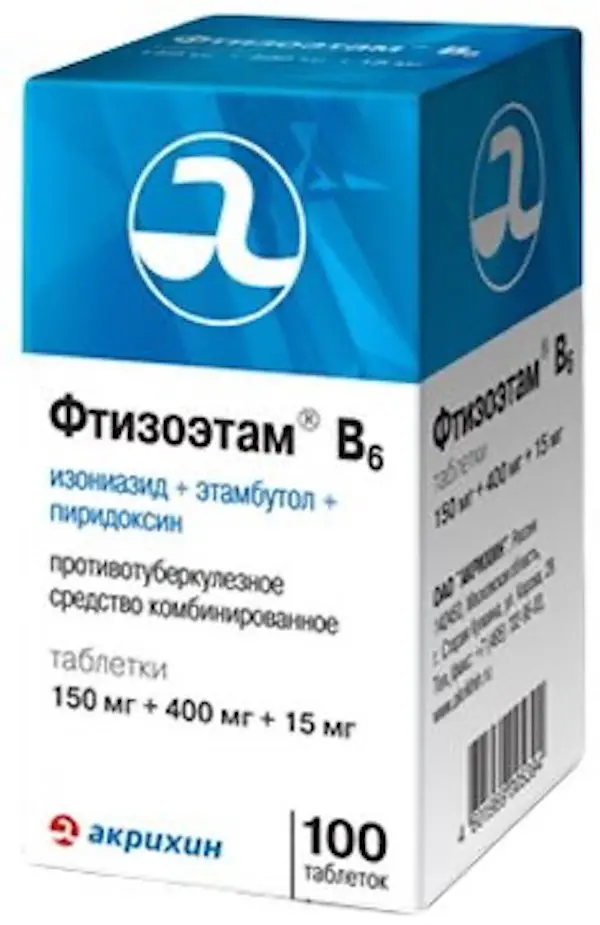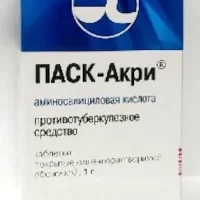Description
Ethambutol, isoniazid, pyridoxine (Phthizoetham B6) Pharmacodynamics
Combined anti-tuberculosis drug.
Isoniazid is an anti-tuberculosis drug; it acts bacteriostatically. It is a prodrug – mycobacterial catalase-peroxidase metabolizes isoniazid to the active metabolite, which, by binding to enoyl-(acyl transfer protein)-reductase fatty acid synthase II, disrupts conversion of delta2-unsaturated fatty acids into mycolic acid. The latter is a branched-chain fatty acid, which, when combined with arabinogalactan (polysaccharide), is involved in the formation of Mycobacterium tuberculosis cell wall components. Isoniazid is also an inhibitor of mycobacterial catalase-peroxidase, which reduces the microorganism’s defense against reactive oxygen species and hydrogen peroxide.
Isoniazid is also active against a small number of Mycobacterium kansasii strains (in infections caused by this pathogen, sensitivity to isoniazid should be determined before starting treatment).
Etambutol acts bacteriostatic; it penetrates into actively growing mycobacterial cells, inhibiting RNA synthesis, disrupts cellular metabolism, causes cessation of reproduction and death of bacteria. It is active only against intensively dividing cells. Inhibits growth and reproduction of Mycobacterium tuberculosis bacteria resistant to streptomycin, isoniazid, PASC (aminosalicylic acid), ethionamide, kanamycin. Minimum inhibitory concentration (MIC) is 0.78-2 mg/L. It has no effect on non-tuberculosis pathogens.
Pyridoxine is a vitamin B6, it participates in metabolism and is necessary for normal functioning of the central and peripheral nervous system. After entering the body it is phosphorylated, converted into pyridoxal-5-phosphate and is a part of enzymes that perform decarboxylation, transamination and racemization of amino acids, as well as enzymatic conversion of sulfur-containing and hydroxylated amino acids.
It participates in tryptophan metabolism (participation in serotonin biosynthesis reaction).
Indications
Treatment and prophylaxis of all forms of tuberculosis caused by M. tuberculosis sensitive to isoniazid and ethambutol, as part of combination therapy.
Current official guidelines on the rules for administration of antibacterials must be taken into account.
Contraindications
Ethambutol, isoniazid, pyridoxine (Phthizoetham B6) tablets are contraindicated in children under 12 years of age, patients with hypersensitivity to isoniazid, ethambutol or any other component of the drug; in patients with epilepsy and other diseases accompanied by the tendency to convulsions, uncontrolled arterial hypertension, severe coronary insufficiency, cirrhosis of the liver, medicinal hepatitis and/or other severe adverse reactions developed during previous treatment with the preparation containing isoniazid, acute liver disease, hepatic insufficiency of severe degree myxedema, optic neuritis, cataract, diabetic retinopathy, bronchial asthma, psoriasis, hyperuricemia, acute gout, peptic ulcer, duodenal ulcer, pregnancy and lactation.
Dosage and administration
Administered orally, after a meal, once a day.
Treatment .
Phthizoetham B6 is taken orally, after a meal, once a day. Dosage of Phthizoetham B6 isoniazid: 5-10 mg/kg of patient weight. The drug is used daily during intensive therapy (3-4 months), every other day thereafter. Total course dose of Phthizoetham B6 for each patient is individual and depends on character of disease, efficacy of treatment and tolerance.
Prophylaxis
Orally, 5-10 mg/kg/day, the maximum daily dose is 600 mg.
Doses and duration of administration should be determined according to the official current federal guidelines for tuberculosis.
In patients with renal impairment.
Recommended doses and frequency of administration for patients with creatinine clearance less than 30 mL/min and in hemodialysis are 300 mg once daily.
Patients with hepatic insufficiency
Phthizoetham B6 has hepatotoxic effect, therefore in patients with liver dysfunction of moderate or mild degree it is administered with strict monitoring of liver enzymes and usage of hepatoprotectors. Phthizoetham B6 is contraindicated in patients with severe hepatic insufficiency.
In severe pulmonary and cardiac insufficiency, marked atherosclerosis, coronary heart disease and arterial hypertension, do not prescribe in doses greater than 10 mg/kg.


